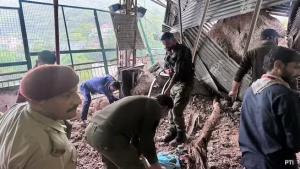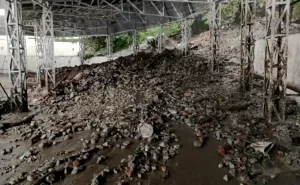Jammu – The catastrophic Vaishnodevi Landslide has claimed 32 lives and left 20 people injured, officials confirmed on Wednesday. The devastating incident occurred on Tuesday afternoon along the popular pilgrimage route to the revered Vaishno Devi shrine in Jammu and Kashmir’s Reasi district. The Vaishnodevi Landslide struck around 3 PM, catching pilgrims completely off guard as they made their way to the hilltop shrine.
Heavy, relentless rainfall triggered the Vaishnodevi Landslide when the mountainside collapsed, sending stones, boulders, and rocks hurtling down the slope. The disaster occurred approximately halfway along the winding 12-kilometer trek from Katra to the shrine, a route regularly used by thousands of devotees. The pilgrimage was immediately suspended following the Vaishnodevi Landslide, with authorities scrambling to launch rescue operations in the treacherous conditions.
Route Suspension and Safety Concerns

The shrine authorities had already suspended the yatra on the Himkoti trek route since morning due to adverse weather conditions. However, pilgrims were still permitted to use the old route until 1:30 PM, when officials finally decided to suspend all pilgrimage activities. The Vaishnodevi Landslide occurred just hours after this decision, raising serious questions about the timing of the suspension and whether earlier action could have prevented the tragedy.
Two main routes lead to the shrine, and while one had been closed since morning, the continued operation of the old route proved fatal. The Vaishnodevi Landslide has highlighted the urgent need for better coordination between weather monitoring agencies and pilgrimage authorities to ensure visitor safety during adverse weather conditions.
Administrative Negligence Under Fire

The Vaishnodevi Landslide has intensified criticism of Lieutenant Governor Manoj Sinha’s administration for what many are calling “criminal neglect.” Despite weather alerts forecasting very heavy rain with possibilities of cloudbursts, flash floods, and landslides, the administration continued to allow pilgrimage activities. The Vaishnodevi Landslide marks the third major rain-related incident in just 12 days, bringing the total death toll to 136 lives across Kishtwar, Kathua, and Reasi districts.
A senior police officer, speaking anonymously, criticized the administration’s delayed response to weather warnings. “When meteorological department had been regularly issuing weather forecasts on hourly basis alerting the administration about heavy rains, cloudbursts, flash floods and landslides, the administration showed ‘criminal neglect’ in not suspending the pilgrimage,” the officer stated. The Vaishnodevi Landslide could have been avoided with timely intervention, according to critics.
Pattern of Tragic Incidents


The Vaishnodevi Landslide follows a disturbing pattern of rain-related disasters in the region. At least 65 pilgrims died in Kishtwar on August 14, with 32 still missing, while seven people, including five minors, lost their lives in a cloudburst in Kathua on August 17. The Vaishnodevi Landslide adds to this mounting toll, raising serious concerns about disaster preparedness and response mechanisms in the region.
Local residents have pointed to environmental factors contributing to the Vaishnodevi Landslide. Deepak Kumar, a Katra local, attributed the disaster to rampant tree cutting and new track construction to the cave shrine. “We had never seen before such death and destruction on Trikuta Hills. The shrine board has ruined these hills just to increase the footfall of pilgrims,” Kumar said regarding the Vaishnodevi Landslide aftermath.
Accountability and Investigation Demands
The Vaishnodevi Landslide has prompted calls for accountability from various quarters. Critics have specifically blamed the Katra and Padder sub-divisional magistrates and the shrine board for the 32 deaths. Senior journalist Rohit Jandial emphasized that announcing monetary relief and offering condolences cannot absolve the administration of its responsibility following the Vaishnodevi Landslide.


Chief Minister Omar Abdullah announced plans for a comprehensive probe once rescue and relief operations conclude. The investigation will examine the reasons behind the Vaishnodevi Landslide and the administrative response to weather warnings. This announcement comes amid growing pressure for transparency and accountability in the wake of repeated tragedies.
Historical Context and Safety Measures
The Vaishnodevi Landslide is not the first tragedy to strike the pilgrimage route. On January 1, 2022, at least 12 pilgrims died and scores were injured in a stampede at Bhawan. Following that incident, Lieutenant Governor Sinha had ordered a high-level probe headed by a three-member panel, though the findings were never made public.
As rescue operations continue and families mourn their losses, the Vaishnodevi Landslide serves as a stark reminder of the urgent need for improved safety protocols, environmental protection, and responsive governance to prevent future tragedies on this sacred pilgrimage route.

